PHY137H5 Lecture 3: Gauss's Law
90 views3 pages
Document Summary
Relevance a method of calculating the electric field over an area as opposed to a point. The key part of gauss"s law is the electric flux (the electric field per area in space). The electric flux can be calculated as follows: Where e is the electric field intensity and a is the area. If an angle is involved, then the cosine of the angle is considered. If e is parallel to a, then the flux is simply the electric field intensity multiplied by the area. If e is and a are at an angle, then the flux is equal to e*a multiplied by the cosine of the angle. If e and a are parallel, then the flux is equal to zero. More field lines=stronger electric field (because more force) Gauss"s law is a very powerful tool in calculating electric fields if the area is symmetrical. Gauss"s law is useful for calculating electric fields in the following situations:
Get access
Grade+20% off
$8 USD/m$10 USD/m
Billed $96 USD annually

Homework Help
Study Guides
Textbook Solutions
Class Notes
Textbook Notes
Booster Class
40 Verified Answers
Class+
$8 USD/m
Billed $96 USD annually

Homework Help
Study Guides
Textbook Solutions
Class Notes
Textbook Notes
Booster Class
30 Verified Answers

